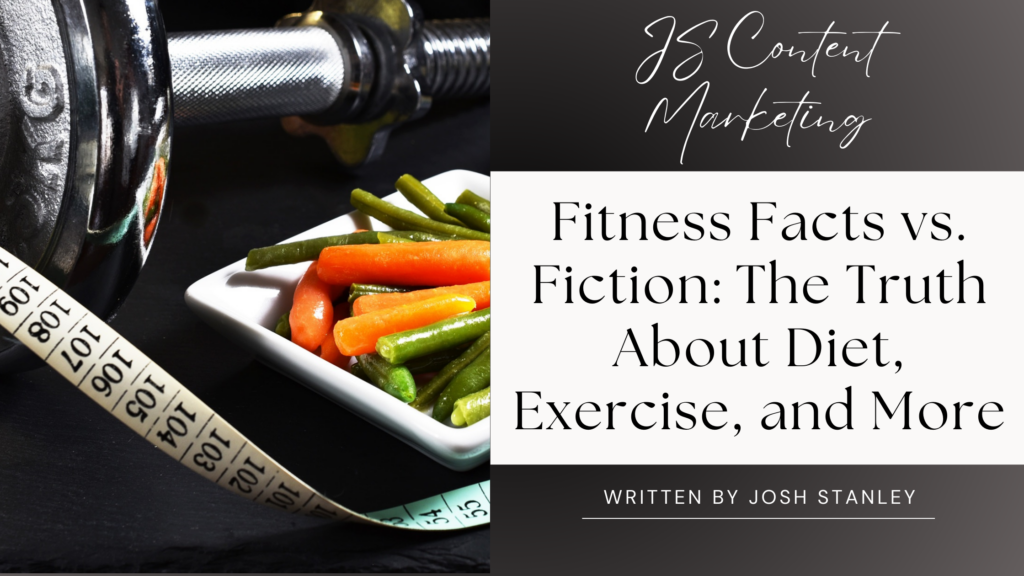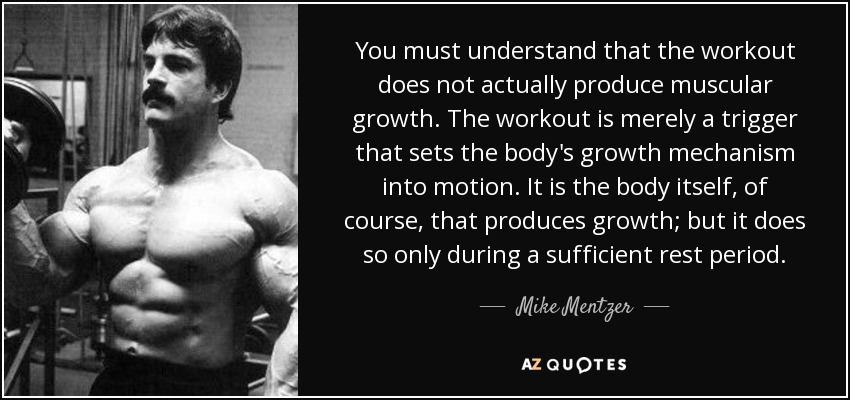Fitness Facts vs. Fiction: The Truth About Diet, Exercise, and More

Staying on the path to better health can mean you’re in for a long, winding journey.
The many diet and workout options in the fitness world can function as detours along your trip. Some may lead you forward while following the wrong path could set you back.
Understanding what works and what doesn’t is crucial for reaching peak fitness. The right approach to diet, exercise, and an overall healthy lifestyle will ensure you reach your fitness goals in the safest, most efficient manner possible.
That’s why today we’re going to discuss some common fitness ideas and determine once and for all whether they’re more fact or fiction.
10 Health and Fitness Concepts: Are They True, False, or Somewhere in Between?
The world of health and fitness is full of advice—some of it helpful, some of it misleading, and some falling somewhere in between. With so much information out there, it’s easy for key concepts to get misinterpreted or taken out of context.
To make informed decisions about your health, it’s important to separate fact from fiction. Below, we’ll break down 10 common health and fitness claims and give a verdict on how accurate each one is.
01. Weight Loss is About Calories (Partially True)
Weight loss is perhaps the most common health and wellness goal of all. A quick search will reveal the essential formula for shedding pounds—maintaining a calorie deficit.
The core concept is simple: if you consistently eat fewer calories than you expend, you’ll lose weight. However, some take this as a free pass to eat anything, as long as they stay within their calorie limit. While it’s technically possible to lose weight on junk food alone, doing so can increase your risk for:
- Diabetes
- Heart disease
- Tooth decay
In addition, junk food lacks true nutritional value. Loading up on it will leave you feeling hungry and negatively impact exercise performance. Instead of just counting calories, focus on where your calories come from. Prioritize lean proteins, complex carbohydrates, and healthy fats to fuel your body and support long-term health.
02. You Can Work Out Two Days in a Row (Depends)
For those dedicated to fitness, the gym can feel like a second home. Working out frequently can build both physical and mental momentum, helping establish a healthier lifestyle. But whether it’s beneficial to train two days in a row depends on the type and intensity of exercise.
If you’re doing light weightlifting, moderate cardio, or simple stretching, back-to-back workouts are generally fine—as long as you take at least one or two rest days per week. However, intense training requires longer recovery periods. If you’re lifting to failure, sprinting, or pushing through high-intensity workouts, training on consecutive days can be counterproductive.
Even if you switch muscle groups, your body still needs time to replenish biochemical resources and recover from the systemic effects of intense exercise. Skipping recovery can lead to fatigue, impaired performance, and even injury. For maximum results, listen to your body and allow at least 24-48 hours of rest after high-intensity sessions.
03. Crunch Your Belly Fat Away (Mostly False)
We all have areas of our body we’d like to work on. How about the midsection? For many people, this is where excess fat tends to accumulate, and what says fit more than six-pack abs?
With this in mind, many people hit the floor doing tons of crunches in hopes of burning away that belly fat. However, the body loses fat as a single unit. This means you’ll lose it from head to toe, and there’s no way to tell the rate at which it will dissipate from your midsection.
However, this doesn’t mean your crunches are useless. As long as you’re burning calories, you will be moving toward a leaner, fitter body. If your workouts build muscle, they can also help shape and define your midsection. Strength training increases muscle mass, which not only improves tone but also allows your body to store more glycogen. This means your muscles can hold onto carbohydrates for energy rather than converting them into fat.
04. Carbs Are the Enemy (Mostly False)
Carbohydrates often get a bad reputation, but they’re not inherently bad. The truth is, carbs are a primary energy source for your body, especially when it comes to physical activity and brain function. Whether they help or hurt your fitness goals depends on the type of carbs you consume and how they fit into your overall diet.
Not all carbs are created equal. Highly processed, refined carbs—like white bread, pastries, and sugary snacks—can lead to blood sugar spikes and contribute to fat gain when consumed in excess. On the other hand, healthy carbs can provide essential nutrients, fiber, and steady energy. You can get them from:
- Whole grains
- Fruits
- Vegetables
- Legumes
For those who lift weights or engage in intense exercise, carbs are especially beneficial. They help replenish glycogen stores, ensuring your muscles have the fuel needed for performance and recovery. However, dietary needs vary based on your fitness goals. Some low-carb or ketogenic diets can work well for fat loss, while high-carb diets may be better for endurance athletes.
05. Rest is Crucial for Gaining Muscle (True)
High-intensity training programs are popular among those looking to build muscle size and strength. Many of these routines encourage training to failure—pushing muscles to their limit to stimulate growth. However, some lifters become so focused on making gains that they skip rest days, thinking more training equals faster results.
In reality, muscle growth doesn’t happen in the gym—it happens during rest. Workouts create microtears in muscle fibers and deplete the body’s resources. Recovery time allows the body to repair, rebuild, and strengthen muscles. As bodybuilding legend Mike Mentzer explained, intense workouts create a “deficit” in the body’s resources. Before growth can even begin, those resources must first be replenished.

Rest days aren’t wasted time—they’re essential. A minimum of two full rest days is recommended for high-intensity training, and some individuals may need even more. Skipping recovery can impede muscle growth and lead to injuries. If you want to maximize muscle growth, prioritize rest as much as your workouts.
06. Eat Big to Get Big (False)
What should you do on rest days to support muscle growth? For many, the answer seems obvious: eat more. After all, if you want bigger muscles, you need to fuel them with extra calories, right? Not exactly.
While a modest calorie surplus—around 10-20% above maintenance calories—can support muscle growth, overeating won’t make muscles grow any faster. The idea that “more is better” doesn’t apply here, just like doing more sets or training more frequently won’t speed up muscle gains. Excess calories, beyond what your body can use for muscle repair and growth, are simply stored as fat.
Muscle is primarily composed of protein and water, but consuming excessive amounts of these or other nutrients won’t fast-track your progress either. The best way to complement high-intensity training and proper rest is a healthy, balanced diet and an appetite for patience.
07. Light Exercise is as Beneficial as Heavy Exercise (True)
Not every workout has to be intense to be effective. While heavy lifting and high-intensity training are great for building muscle and endurance, light exercise offers its own set of powerful benefits.
Activities like walking, yoga, and low-impact strength training improve circulation, aid recovery, reduce stress, and enhance overall well-being. Light exercise also helps maintain consistency—making it easier to stay active long-term without overtraining or risking injury.
Unlike intense exercise, lighter workouts come with lower nutritional and rest requirements. Yet despite this, they can be superior for longevity, mobility, and overall health. You can also mix up heavy and light workouts to keep your workout routine fresh and invigorating.
08. Protein Shakes Are Needed for Muscle Growth (Depends)
Protein is essential for muscle repair and growth, but getting enough daily protein is what truly matters—not the source. Whey protein shakes themselves aren’t required for muscle building, but they’re useful if you can’t get enough protein from lean meats, eggs, dairy, nuts, and other sources.
Whey, a component of milk, is a natural source of protein. These shakes have many advantages, such as:
- Convenience: Easy to mix with water or milk for a quick protein boost.
- Affordability: Offers a high amount of lean protein relative to the price.
- Time-efficient: Portable and fast to consume—perfect for busy schedules.
- Calorie-efficient: Delivers a high protein-to-calorie ratio, great for lean diets.
If you struggle to get enough protein through food alone, shakes can help fill the gap, especially post-workout. Whether you’re short on time, cutting calories, saving money, or not in the mood to cook, these shakes are a perfect solution to hit your daily protein goals.
09. Water Alone is Sufficient for Hydration (Partially True)
Water is essential for hydration, but it doesn’t contain electrolytes—key minerals that help regulate fluid balance in the body. While water does a great job at keeping you hydrated, it lacks the components necessary to replenish the electrolytes lost during intense physical activity or sweating.
Electrolytes like sodium, potassium, calcium, and magnesium help maintain muscle function, nerve signaling, and proper hydration levels. Without these minerals, your body can experience cramping, fatigue, and dehydration, especially during or after intense exercise or prolonged exposure to heat.
To properly hydrate, consider electrolyte-infused water, fruit juices with natural electrolytes, or electrolyte supplements. These options help restore balance by providing essential minerals, ensuring your body stays hydrated and functions at its best.
10. Train More as You Get Stronger (False)
We end our list with another myth of the weight room, but one that’s easy to fall for. Conventional wisdom says that the only way an advanced lifter with significant muscle mass can get bigger and stronger is to train more.
Beginner and intermediate lifters don’t have the muscle mass to overtrain as easily. But for heavy-duty lifters and strength athletes who are lifting heavier weights regularly, the chance of ligament, tendon, and joint damage is more prevalent, as is the risk of overtraining due to the required level of rest necessary to promote additional muscle growth.
As we’ve covered, more is not always better. High-intensity training places greater stress on the body, increasing the risk of overtraining and injury. Advanced lifters handling heavy weights may benefit from reducing training volume and frequency while prioritizing longer rest periods for proper recovery and muscle growth.
The Best Approach to Fitness is One Focused on Facts
Whether you’re looking to lose weight, build muscle, refine your diet, or stay consistent with your fitness progress, having a clear, fact-based approach will set you up for success.
It’s easy to be misled by fad diets, flashy workout trends, or even well-intended but inaccurate advice. But the 10 tips above help clarify common health and wellness misconceptions that might be slowing you down.
Clearing up fitness misconceptions can feel like lifting a weight off your shoulders—or better yet, like holding the right weight in your hands, allowing you to train smarter, safer, and more effectively.
If you’re looking for more health and wellness content that’s rooted in facts, science, and proven strategies for results, contact me today. I’m a passionate content marketer who specializes in content creation, strategy, and management. Whether you want gains in the gym, in marketing ROI, or both, I’m your guy.

